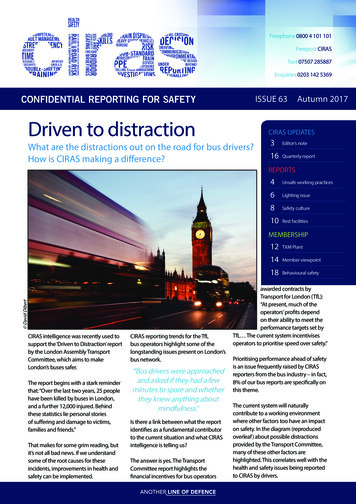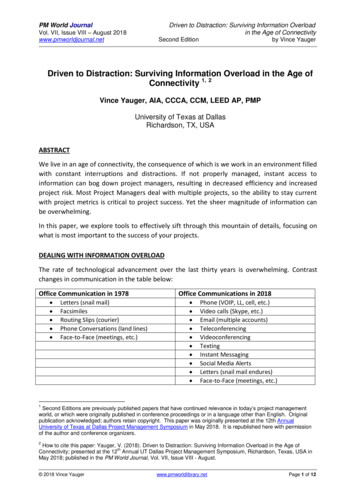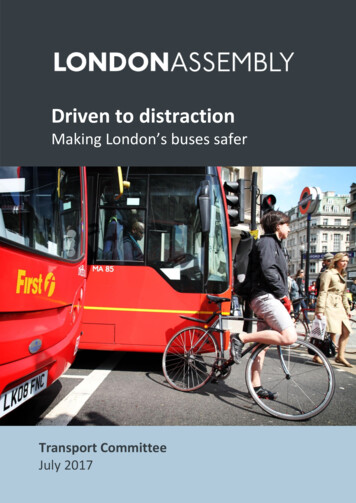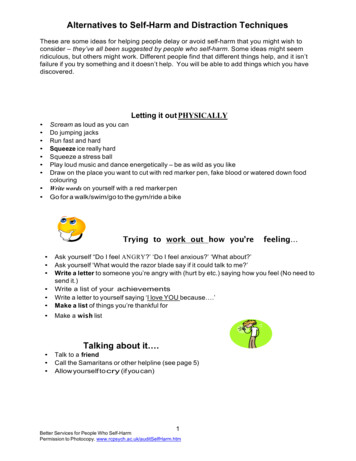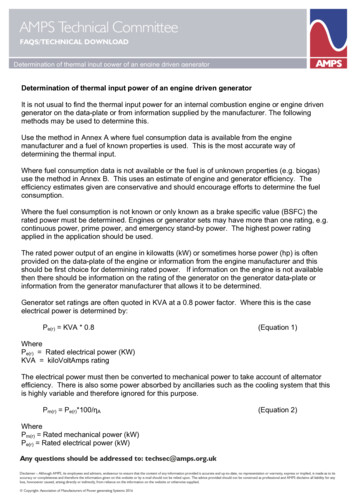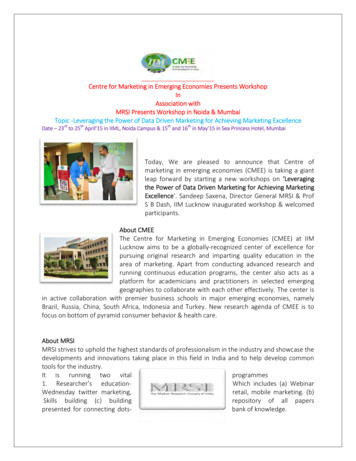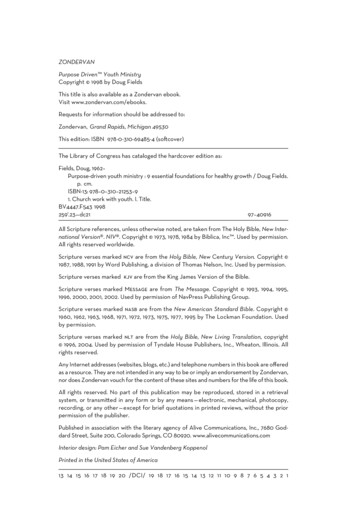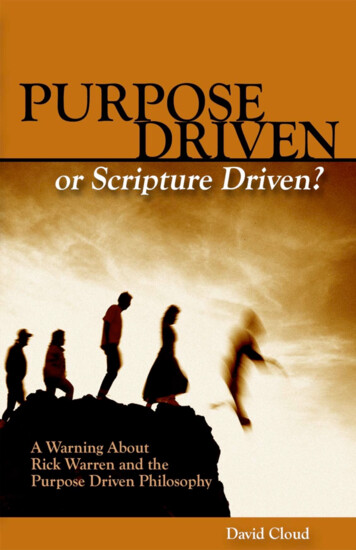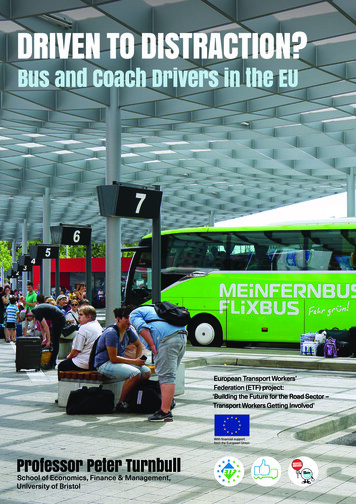
Transcription
DRIVEN TO DISTRACTION?Bus and Coach Drivers in the EUEuropean Transport Workers’Federation (ETF) project:‘Building the Future for the Road Sector –Transport Workers Getting Involved’With financial supportfrom the European UnionProfessor Peter TurnbullSchool of Economics, Finance & Management,University of Bristol
Author: Professor Peter Turnbull, School of Economics, Finance & Management, University of BristolResearch assistance was provided by: Andrjez Branski, Yash Daga, Yilan Huang, Omar Vega Kurson,James Risk and Tim Tillett (Department of Management, School of Economics, Finance &Management, University of Bristol).Design: Louis Mackay / www.louismackaydesign.co.ukContact: Cristina Tilling / road@etf-europe.org ETF, January 2018All rights reserved, no part of this publication may be reproduced, stored in a retrieval system, ortransmitted by any means, electronic, mechanical, photocopying, or otherwise, without the priorpermission of the European Transport Workers’ Federation (ETF).Galerie AgoraRue du Marché aux Herbes 1051000 Brussels – BELGIUMTel: 32 2 285 46 .euwww.facebook.com/ETFRoadSection/The ETF represents more than 5 million transport workers from more than 230 transport unions and41 European countries, in the following sectors: railways, road transport and logistics, maritimetransport, inland waterways, civil aviation, ports & docks, tourism and fisheries.
DRIVEN TO DISTRACTION? LONG-DISTANCE COACH AND BUSDRIVERS IN THE EUEuropean Transport Workers’ Federation (ETF) project‘Building the Future of the Road Sector – Transport Workers GettingInvolved’ 11Reference Number: VS/2016/0246 (0299)2
ContentsI.II.III.IV.V.VI.SummaryMarket Access, Competition and Social Protection: The Road to (re)RegulationA Roadmap to Navigate this ReportNew Business Models in the European Market for International Coach and Bus TransportDrivers’ Conditions of Work and EmploymentConclusion – Taking a Rest from the RegulatorsAbbreviationsCORTEDG MoveECRETFEUEWCSConfederation of Organisations in Road Transport EnforcementDirectorate-General for Mobility and TransportEuroContrôle RouteEuropean Transport Workers’ FederationEuropean UnionEuropean Working Conditions SurveyList of TablesTable 1. Total Offences for Bus and Truck Inspections, 2016Table 2. Bus Offences, 2012-16Table 3. Number of Drivers by Company SizeTable 4. The Highs and Lows of Drivers’ RemunerationTable 5. Employer’s Provision of Benefits: All, Union and Non-Union DriversTable 6. Employer’s Provision of Benefits: Full-time vs. Agency DriversTable 7. What do Companies Pay Drivers to do?Table 8. Working During Rest Time3
I.SummaryEU regulations for the international road passenger transport market, including driving timeregulations, have failed to maintain social standards for drivers. Enforcement agencies are underresourced but still find extensive violation of drivers’ hours during inspection weeks, especially whenthese driving time offences are targeted by inspectors. The working environment for bus and coachdrivers is often poor and cost-competition arising from new (platform) business models is drivingdown terms and conditions of employment. The new ‘business partnerships’ that have emerged arebetween the ‘platform’ (e.g. FlixBus) and local coach operators – these are not partnerships betweenmanagement and labour as drivers are often more insecure, their pay is less predictable, the demandson their working (and non-working) time are ever greater, and they are often denied trade unionrepresentation.This report focuses on a survey of almost 700 bus and coach drivers, which reveals that many driversdo not enjoy basic social benefits and protection (e.g. holiday and sick pay, health insurance and accessto training). Agency and temporary drivers, in particular, are less likely to enjoy such benefits. Drivers’pay is often low and highly variable, both week-to-week (depending on hours worked) and season-toseason (pay is higher in the peak season). Some are not even provided with a detailed pay slip by theiremployer. Additional work demands (e.g. cleaning the coach) extend the working day and can eat intosocial/family time (e.g. studying routes and checking toll charges). Very few drivers are paid for thetime they spend driving to/from work, which can further extend the working day. Even when they arenot working, their daily and weekly rest time is frequently interrupted, which further adds to fatigueand increases the risk of ‘occupational burnout’. When overworked and fatigued, drivers can be‘driven to distraction’, putting themselves, their passengers and other road users at risk.II.Market Access, Competition and Social Protection: The Road to(re)RegulationRegulation (EC) No 1073/2009 2 provides a set of common rules for access to the international marketfor coach and bus services, specifically how: carriers from all Member States should be guaranteed access to international transportmarkets without discrimination on grounds of nationality or place of establishment;regular services provided as part of a regular international service should be opened upto non-resident carriers (“cabotage”);authorisation could be refused if the service would seriously affect the viability of acomparable service operated under one or more public service contracts (PSCs); andadministrative formalities should be reduced as far as possible.An ex-post evaluation of the Regulation undertaken by the Commission concluded that there is now amore coherent framework for international services, with clear progression towards theestablishment of an internal market. 3 However, the inter-urban coach and bus sector has failed togrow at a rate comparable to that of other transport modes and its modal share has continued toThe Regulation came into force in December 2011, replacing Council Regulations (EEC) 684/92 and (EC) No 12/98.Commission Staff Working Document (2017a) Ex-post evaluation of Regulation (EC) No 1073/2009 of the EuropeanParliament and of the Council of 21 October 2009 on common rules for access to the international market for coach and busservices, Executive Summary, SWD(2017) 360 final. Although market opening has been accompanied by improvements inthe level of service, a growth in the number of operators, passengers and services, it is unclear how much of this growth canbe attributed to the Regulation.234
decline. 4 The Commission attributes this ‘under-performance’ to ‘a wide range of restrictions onaccess to national markets limiting competition between operators and against other modes’, 5described as a ‘patchwork of rules for access’ that ‘constrains carriers’ ability to develop services intopan-European coach networks and denies them the possibility to offer integration with other coachservices and transport modes’. 6A new REFIT initiative (regulatory fitness and performance revision) of current law – a procedure putin place by the Commission to ‘test’ current EU rules – has been proposed to simplify and reduceregulatory costs while maintaining benefits, based on a combination of two policy options:1)2)open access to the inter-urban market for regular services of 100km or more, with thepossibility to refuse an authorisation if the economic equilibrium of an urban publicservice contract (PSC) is compromised, andequal access rules for terminals 7This proposal for a Regulation amending the rules on access to the international market for coach andbus services (No 1073/2009) is part of a broader on-going review of the European Union’s (EU) roadtransport legislation, specifically legislation on: access to the profession (Regulation (EC) No1071/2009), working, driving and rest time legislation (Regulation (EC) No 561/2006), Directive2002/15/EC and Regulation (EU) 165/2014) and the Eurovignette (Directive 1999/62/EC). It isanticipated that, as a result of the Commission’s new mobility package, 8 market and social issues inthe road passenger transport sector will become more interdependent:‘The links between the social and the internal market provisions are most prominent. The abuseof internal market rules by applying illegal business practices, such as: illegal cabotage, fakeestablishment in low-cost countries, have adverse effects on drivers’ working conditions andoften deprive them from their social protection rights. In the same vein, the misapplication ofthe social rules in road transport by non-respecting the driving, working or resting timerequirements or applying the terms and conditions of employment of the low-wage country todrivers working most of the time in high-wage countries disrupts fair competition betweenoperators by unfair cost gains. Therefore, solving the social challenges in the sector must gohand in hand with addressing the internal market problematic issues’. 9A constant challenge created by the EU’s liberalisation agenda is the ‘disconnect’ between economic(market-making) and social (market-correcting) policies – the former makes the latter more difficultto enforce and the latter invariably ‘lags behind’ the former (i.e. markets are ‘made’ and then policymakers must deal with the anticipated and unanticipated social problems that the open marketthrows up). 10 These problems are most pronounced in international transport markets where bothIn particular, the sector has not kept pace with the private car as a means of making longer distance journeys.Commission Staff Working Document (2017a), op. cit.6 European Commission (2017) Proposal for a REGULATION OF THE EUROPEAN PARLIAMENT AND OF THE COUNCIL amendingRegulation (EC) No 1073/2009 on common rules for access to the international market for coach and bus services, COM(2017)647 final, p.3.7 Ibid.8 Europe on the Move, go to: 7-05-31-europe-on-the-move en9 Commission Staff Working Document (2017b) Impact Assessment accompanying the document: Proposal for a Regulationof the European Parliament and of the Council amending Regulation (EC) No 1073/2009 on common rules for access to theinternational market for coach and bus services, SWD(2017) 358 final, p.56.10 Scharpf, F.W. (2010) ‘The asymmetry of European integration, or why the EU cannot be a “social market economy”’. SocioEconomic Review, 8(2): 211-250.455
capital and labour are highly mobile. 11 Ipso facto, we can expect further social problems to arise fromthe Commission’s Proposal to amend Regulation (EC) No 1073/2009, reinforcing and exacerbatingexisting social problems that appear to have been largely overlooked in the Impact Assessmentaccompanying the REFIT Proposal.12 One of the many criticisms made by the Regulatory ScrutinyBoard 13 was that the Impact Assessment failed to discuss whether labour market policies are neededto avoid an erosion of labour market standards over time. DG Move’s response to this criticism wassimply to state that, in bus and coach sector, ‘the posting of workers’ rules will ensure both fairworking conditions for drivers and fair competition between operators’. 14The Commission anticipates that, by strengthening enforcement and administrative cooperationbetween Member States in the social rules, this will be sufficient to ensure fair working and businessconditions, i.e. ‘a balance between the freedom to provide road transport services and adequateworking conditions and social protection of transport workers’. 15 Thus, while recognising that thelatest proposals will increase competitive pressures, ‘the holistic and coordinated response meansthat other initiatives will seek to alleviate the pressure on working conditions from the policy optionson market access. These initiatives will address any potential erosion of labour market standards thatis likely to occur over time and there does not appear to be a requirement for any further labourmarket policies to address these problems’. 16Contrary to this conclusion, the Commission should perhaps be reminded of the age-old adage that:‘competition is not the solution to the problems created by competition’. Moreover, appearances canbe deceptive. While it might ‘appear’ to the Commission that no further labour market policies arenecessary to address the problems that are anticipated by different stakeholders, the difficultiesexperienced in the past in terms of creating a ‘holistic and coordinated enforcement’ do not bode wellfor the future, nor does the failure of existing social rules to protect the working conditions of bus andcoach drivers. Liberalisation is not simply about creating an open market for existing businesses, buta market for new businesses and new business models. These business models exacerbate existing(anticipated) social problems and create new (unanticipated) social problems. These social problemscan drive bus and coach drivers ‘to distraction’, not only in terms of their working time and theintensification of work that accompanies cost-cutting in an increasingly competitive market, but alsoin relation to their general wellbeing and work-life balance.III.A Roadmap to Navigate this ReportThe challenges presented by the emergence of new business models are addressed in the followingsection. The early twenty-first century can be characterised as an era of ‘platform capitalism’,dominated by firms such as Amazon, Google and Facebook that are much more than simply ‘internetcompanies’. Platforms are able to extract, analyse, control and monopolise immense databases,creating a digital infrastructure that enables two or more groups to interact (e.g. drivers andpassengers). ‘Lean platforms’ in the transport sector, such as Uber, attempt to reduce their ownershipof assets to a minimum and to profit by reducing costs as much as possible, especially labour costs. 1711 Turnbull, P. (2010) ‘Creating markets, contesting markets: labour internationalism and the European Common TransportPolicy’, in S. McGrath-Champ, A. Herod and A. Rainnie (eds.) Handbook of Employment and Society: Working Space, EdwardElgar, pp. 35-52.12 Commission Staff Working Document (2017b), op. cit.13 All Impact Assessments are reviewed by the Regulatory Scrutiny Board, which initially issued a negative opinion on DGMove’s draft version of the Impact Assessment.14 Commission Staff Working Document (2017b), op. cit., pp.57 & 87.15 Ibid., pp.56-7.16 Ibid., p.57.17 Srnicek, N. (2017) Platform Capitalism, Polity Press, pp.49-50.6
The word ‘sharing’ is often used to describe the new ‘people-to-people’ economy, but for transportworkers this is not a sharing economy – what is being sold, not shared, is access to a business model(platform) in which the worker carries much more risk in terms of her or his employment security,regularity and predictability of income, health and safety, fair treatment at work, etc.What companies such as Uber do own, of course, is the most important asset: the platform of softwareand data analytics that enables the company to extract monopoly rent. 18 Coach companies are movingin this direction, using web-based ticketing and airline-style yield management with substantialdiscounts for early booking. FlixBus, for example, the German company that emerged followingdomestic liberalisation in 2013, does not own any coaches or employ any drivers, it simply subcontracts the services of regional bus companies that are responsible for the day-to-day running ofroutes. FlixBus controls the platform, providing the administration and permissions required tooperate long-distance and international services alongside network planning, marketing, pricing,quality management and customer service.As bus and coach services are transformed by these new (platform) business models, betterenforcement of existing and/or new rules and regulations is unlikely to be the panacea it is oftenclaimed to represent. The resources of enforcement agencies across Europe have been drastically cutback in recent years, presenting the sector with a loss of capacity in terms of both the number andskills/experience of enforcement personnel, and this comes at a time when enforcement problemscreated by platform capitalism are only just beginning to surface. Infringement and enforcementissues are therefore reviewed in a subsequent section of the present Report in order to highlightpersistent social problems with respect to driving and rest times and the already excessive workloadof many coach and bus drivers.Data on the working conditions of drivers’ is presented in the final substantive section of this Report,based on a questionnaire survey of almost 700 international coach drivers and long-distance driversbetween major cities within one or more Member States. The survey was undertaken during thesummer of 2017 and represents the most comprehensive and contemporary database on workingconditions in the European road passenger transport sector. Based on the workload, driving and resttimes of these drivers, the propriety of the Commission’s latest proposals on changes to Regulation(EC) No 561/2006 on driving and rest time rules are brought into question.IV.New Business Models in the European Market for International andInter-City Coach and Bus TransportIn aggregate, the bus and coach share of EU passenger transport (passenger km) has experienced aslow and steady decline for more than two decades, despite pan-European reforms to open themarket for international services, prevent discrimination on grounds of nationality or place ofestablishment, limit the administrative burden on operators, and promote coach transport as asustainable alternative to individual car transport. 19 In fact, the Comprehensive Study on PassengerTransport by Coach in Europe published by DG Move 20 found little direct evidence of any link betweensome of the recent increases in regular international coach travel and the introduction of Regulation(EC) No 1073/2009, overseeing access to the market of bus and coach services.Uber uses Amazon Web Services (AWS) and relies on Google for mapping.European Commission (2017) Statistical Pocketbook 2017 – EU Transport in Figures, Luxembourg: Publications Office ofthe European Union.20 steer davies gleave (2016) Comprehensive Study on Passenger Transport by Coach in Europe, Final Report, DG Move,European Commission.18197
Domestic liberalisation was evidently more important than the Regulation, although the previouslymentioned Comprehensive Study by the European Commission did note that PolskiBus (an expresscoach operator controlled by Souter Investments, the private investment office of the Scottish coachoperator Stagecoach Group) began services in Poland at the same time as Regulation 1073/2009entered into force. 21 Like other new start-ups, PolskiBus has expanded rapidly – from around 1 millionpassengers in its first year of operations to over 8 million within 3 years 22 – and like other bus andcoach companies uses many of the marketing, yield management and cost-cutting techniquesemployed by low cost airlines (e.g. purchasing tickets on-line and special offers/ early booking ticketspriced as low as 1).Rapid expansion of PolskiBus has created problems for drivers’ schedules and workloads: oneinterviewed driver complained of having to travel 270km from his home in Krakow to Wroclaw thenight before an early start the next day, driving the coach from Wroclaw to Krakow and then back toWroclaw. He then faced a 270km journey back home and only 5 hours sleep before going back on theroad. 23 Others also complained of early (4am) starts, breaks spent ‘under the open skies’, and a heavyworkload: ‘One person [the bus driver] sells tickets, lists passengers, gives information, controls thevehicle, including contacting the dispatcher [un/loading] tons of luggage [some bags weigh] up to40kg, zero rules’.24From 2018, the network (sales platform) of PolskiBus will be connected with FlixBus, Europe’s largestintercity bus network. 25 Liberalisation of the German domestic market in January 2013 is perhaps theclearest example of how new platform businesses can enter the market, rapidly expand by offeringlow fares and ‘special rates’, and then consolidate to create an oligopoly. 26 In 2015, for example,special offers appeared to be the rule rather than the exception: DeinBus (14/12/15) offered 10,000 free tickets in December and JanuaryFlixBus (01/12/15) offered 1 euro tickets for its new international linesPostbus (26/11/15) offered a 15 percent discount on all tickets until 29/11/15Megabus (13/11/15) offered 50,000 free tickets for the entire European networkPostbus (08/09/15) offered every fifth ticket for 5 until 30/09/15With cut-throat price competition comes consolidation as firms cannot sustain low returns on investedcapital. The merger of FlixBus and MeinFernbus resulted in a company with a market share today ofover 70 per cent. 27 Both FlixBus and MeinFernbus sub-contract services to ‘partners’ – already existinglocal bus companies who agree to offer services under the respective (regional or national) inter-urbanbus brand. According to Jochen Engert, co-founder of FlixBus:‘We do everything that goes with the product, we do the scheduling, the network planning, wedo the bus branding, we do all the marketing, communications, we do everything that goes withsales, IT, ticketing, etc., and we do all the service towards the customer we work with over 50companies across the country, and they do the operations for us. They will bring in the assets,they bring in the drivers, they drive the buses for us, and they deliver the product the way wewant them to deliver we have a revenue sharing model, so once a line goes very well they’reIbid., pp.61-2. PolskiBus was founded in 2011.By December 2017, PolskiBus had transported 25 million passengers.23 http://www.gowork.pl/opinie czytaj,88146824 Ibid.25 Tickets can be booked via www.polskibus.com and www.flixbus.pl as well as the FlixBus app.26 steer davies gleave (2016), op. cit., pp.18 and 150-8.27 The company also acquired Postbus in 2016. The public Deutsche Bahn closed down its BerlinLinienBus (the only companyto directly employ its drivers) at the end of 2016, leaving its subsidiary IC Bus as the only significant competitor of FlixBus.21228
going to be very profitable, once it’s not going so well we’re going to share the risk of utilizationwith them’. 28While this arrangement is an attractive proposition for FlixBus, rapidly creating an extensive networkacross Europe, in the words of one trade union official ‘it can be a nightmare for the coachcompanies’. 29 Partners (sub-contractors) with a fixed price per kilometre, and with a performancerelated fee depending on sales and vehicle utilisation, will often shift the risk of utilisation onto theirdrivers via low pay and long hours. 30 Working time is often ‘undocumented’, whether time travellingto/from work, additional duties (e.g. cleaning the bus), and working during breaks. Accurateinformation is hard to come by because the majority of the partners (sub-contractors) have no workscouncil and are hostile to any trade union representation or involvement in the company. Moreover,the Bundesamt für Güterverkehr (national enforcement authority) does not have sufficient capacityto ensure that operators abide by the rules on driving and rest times. 31 When inter-urban buses werechecked during January-June 2015, the total infringement rate was substantially higher than previousyears (almost 27 per cent compared to less than 15 per cent in 2014) and the number of driving andrest time infringements had increased significantly.Germany is not alone in having insufficient capacity to ensure effective enforcement of EURegulations. EuroContrôle Route (ECR) 32 quotes an unpublished European Commission reportrevealing that, across Europe, there has been a 75 per cent reduction in the capacity (personnel andresources) of European road traffic enforcement agencies following the financial crisis. The impact ofthis reduction can prove particularly problematic when knowledge and experience is lost, as only the‘experts among the experts’ are capable of dealing with complex European legislation on drivers’hours, with tachograph manipulation, cabotage, load securing, and the like. 33 More generally, ‘Thereisn’t enough information made available to enable proper targeting of vehicles, so operators knowthe probability of being stopped is next to zero. Current fines are not an effective deterrent, sooperators know they can violate the Regulations with impunity’ (ECR official). 34 More to the point,‘There isn’t a company that doesn’t make some sort of infringement. So the real questions are: howoften, what rules are they infringing, and crucially how intentional is their action?’ 35ECR coordinate control weeks in Member States, with specific weeks dedicated to particular offences(e.g. tachograph fraud/manipulation) or type of vehicles (e.g. holiday buses). 36 When a specificoffence is nominated for particular attention, inspectors record a significantly higher number ofoffences, as demonstrated in Table 1. As a national inspector noted in relation to driving and rest time,‘you don’t find it unless you look for it, look specifically If the Ministry asked if there was aninfringement of driving and rest times [in the event of an accident] we wouldn’t necessarily know’. 37The combined FlixBus/MeinFernbus operation now has over 250 ‘partners’ across Europe.Interview, November 2017.30 Drivers report wages of around 2,200 to 2,400 for 260-280 hours per month.31 Interview, December 2017. Inspections by local police have found infringements in almost half the controlled buses.32 Euro Contrôle Route (ECR) is a group of European Transport Inspection Services working together to improve road safety,sustainability, fair competition and labour conditions in road transport by activities related to compliance with existingregulations. The ‘four pillars’ of ECR’s activities are: (i) coordinated cross border checks, (ii) education and training, (iii)harmonisation, and (iv) consolidation of members’ interests and lobbying.33 Gerard Schipper, General Delegate ECR, presentation to the EU Road Transport Conference, Vilnius, Lithuania, 16thSeptember 2013.34 Interview, July 2017.35 Interview with national traffic inspector, June 2017.36 EU legislation requires six control weeks per annum whereas ECR organise seven control weeks to act as a ‘buffer’ wherecountries may not be able to participate (e.g. due to adverse weather conditions or scheduling difficulties).37 Senior Inspector, Inspectie Leefomgeving en Transport, Netherlands.28299
Table 1. Total Offences for Bus and Truck Inspections, 2016Category of OffenceControlWeekDrivers’HoursTacho fraud/manipulationTechnicalOver-weight 12 tonsOver-weight 12 tonsInsecureloads6,3083193,217796599240Week 10*770152370214315Week 194,4582202,036347516312Week 302,6881502,07832717490Week 374,3942113,356634324288Week 414,3381413,492466320167Week 475,9603503,032501391160Week 6Notes: *Holiday Bus theme in Week 10 (hence lower volumes compared to both Truck and Bus figuresfor other weeks). Figures in bold indicate the theme for that particular week. Drivers’ hours wereidentified as a theme for the first time in 2016. The difference between weeks when drivers’ hourswas a theme (Weeks 6 and 47) and other weeks in 2016 is statistically significant.On average, around 15-20 per cent of controlled holiday buses record an offence each year. 38 In 2017(control week 7), 1,750 buses were controlled, 320 buses (18.3 per cent) recorded offences and 25buses (1.4 per cent) were subject to immediate prohibition. Table 2 reports the number of offencesrecorded each year since 2012 by offence type for bus inspections. Drivers’ hours constitute thelargest number of offences each year, with the exception of 2015.38Maddocks, E. (2017) ECR Analysis, Bristol: Driver & Vehicle Standards Agency.10
Table 2. Bus Offences, 2012-2016Offence20122013201420152016% 58786722,1161,14521.4Drivers’ hours1,1221,6778621,2921,35525.6Tacho 8436731,06019.1Overweight83943564691.4Not allowed tocontinue journey1172342392282434.3Driver documents1461171591211782.9Vehicle documents919111775641*4.1Operator documents4701942753224917.1Any other offences4393792703976478.7Note: * 545 (85 per cent) of Vehicle Document Offences in 2016 were recorded in SpainAccording to the Confederation of Organisations in Road Transport Enforcement (CORTE), a non-profitorganisation established to bring together national transport authorities from European and non-EUcountries having a responsibility and interest in the field of road transport, road security and roadsafety, the rationale behind social legislation is two-fold, namely road safety and fair competition:‘Long and unregulated working hours deteriorates drivers’ concentration and puts road safetyat risk. European road transport social legislation aims to counter any problems which result inreduced road safety. Additionally, social provisions serve to guarantee fair competition betweentransport operators, preventing operators across the EU from benefiting from excessive workinghours’. 39Driver fatigue arises from a combination of poor sleep (especially irregular shift patterns andfragmented sleep), work at all times of day and often night, and sustained task performance. Theeffects of a 1 hour change in the driver’s daily routine due to ‘daylight saving’ (advancing the clock by1 hour) is well-established: there is an increase in driving accidents. 40 European road transportworkers often experience an equivalent or even greater time zone changes in a week, especially ortCoren, S. (1996) ‘Daylight saving time and traffic accidents’, New England Journal of Medicine, 344, p.924.11
they want to spend waking time with their family or engage in other social activities. 41 There
Additional work demands ( e.g. cleaning the coach) extend the working day and can eat into social/family time (e.g. studying routes and checking toll charges). . ‘driven to distraction’, putting themselves, their passengers and other road users at risk. II. Mark
